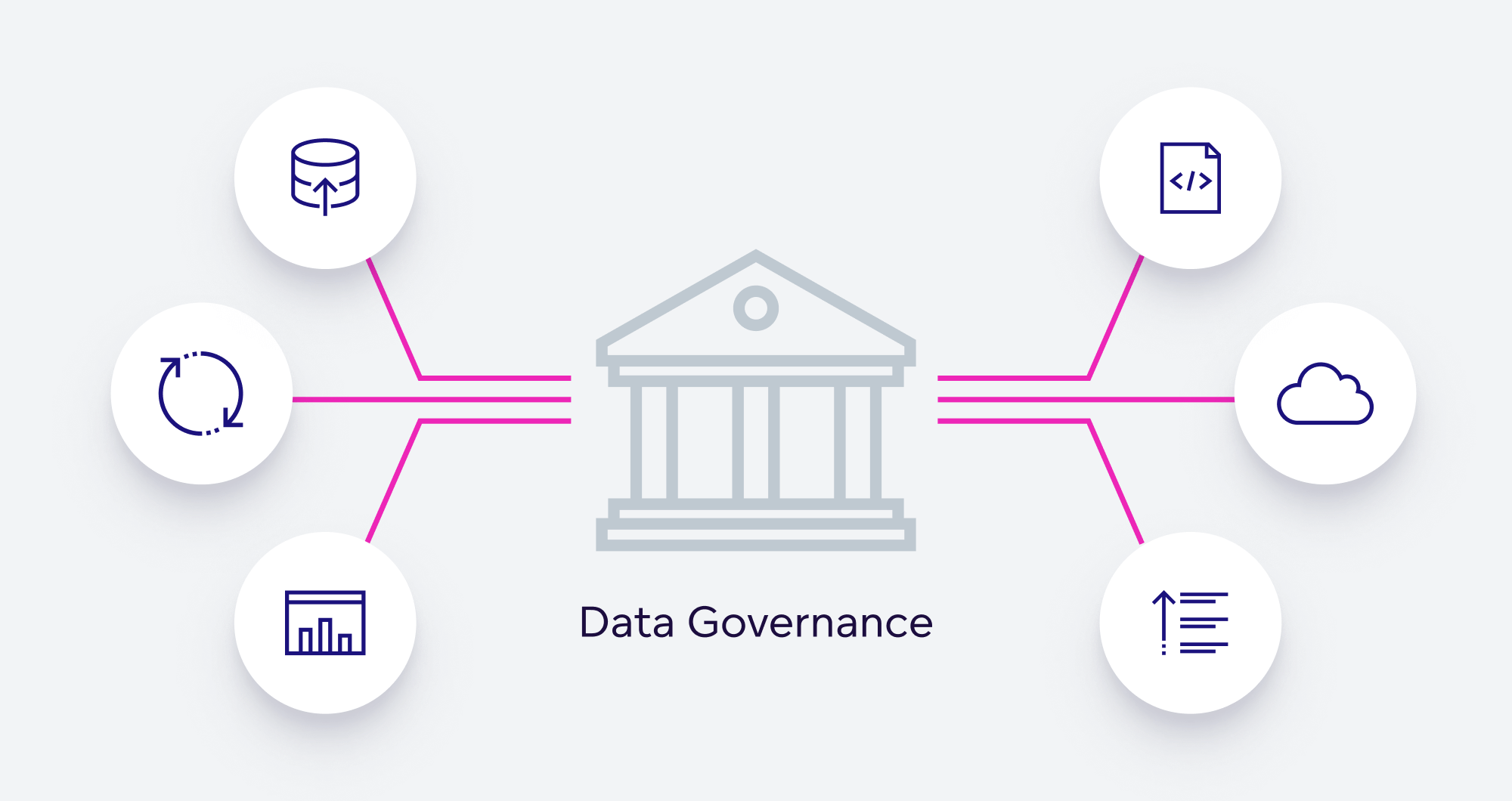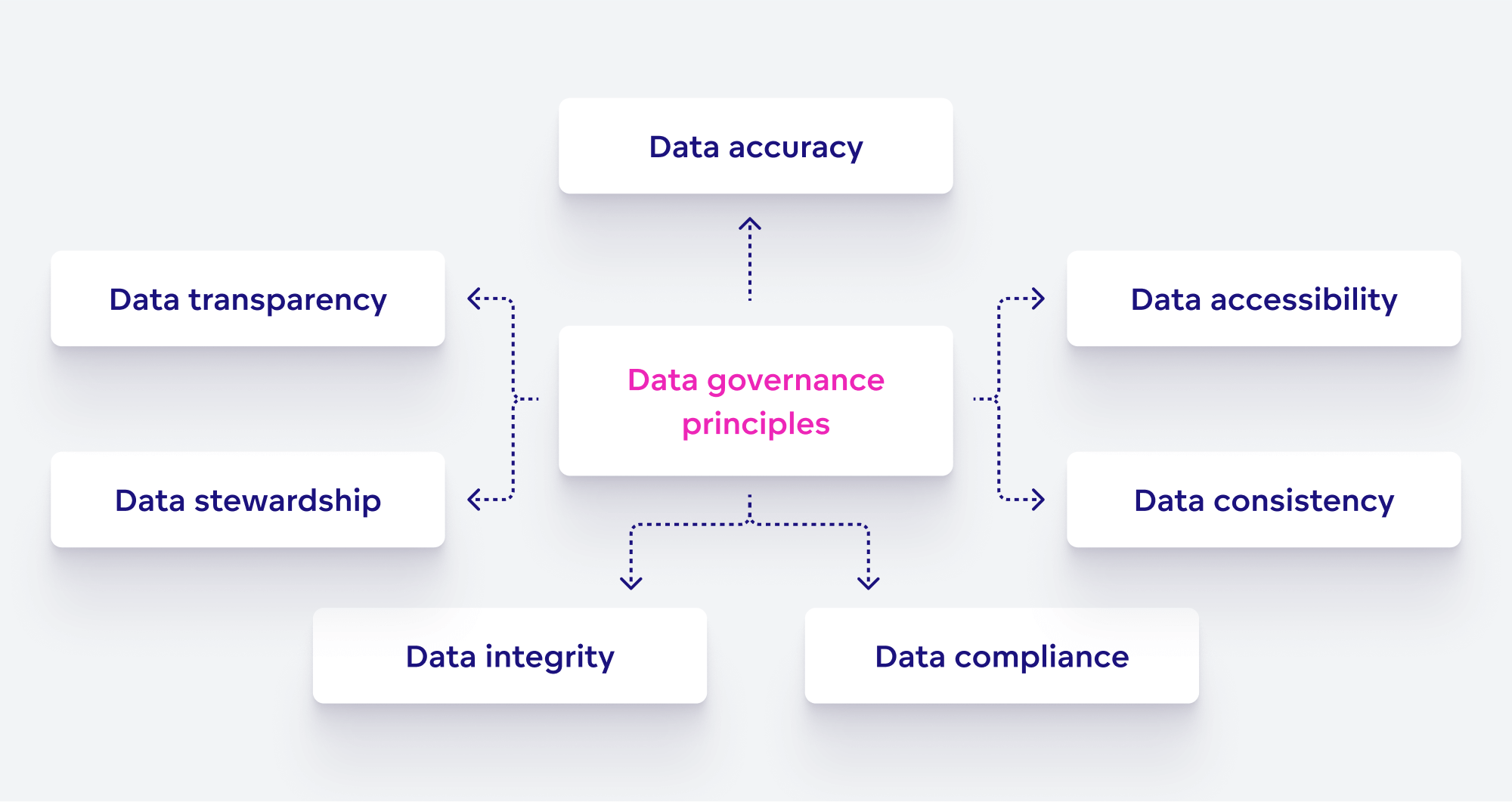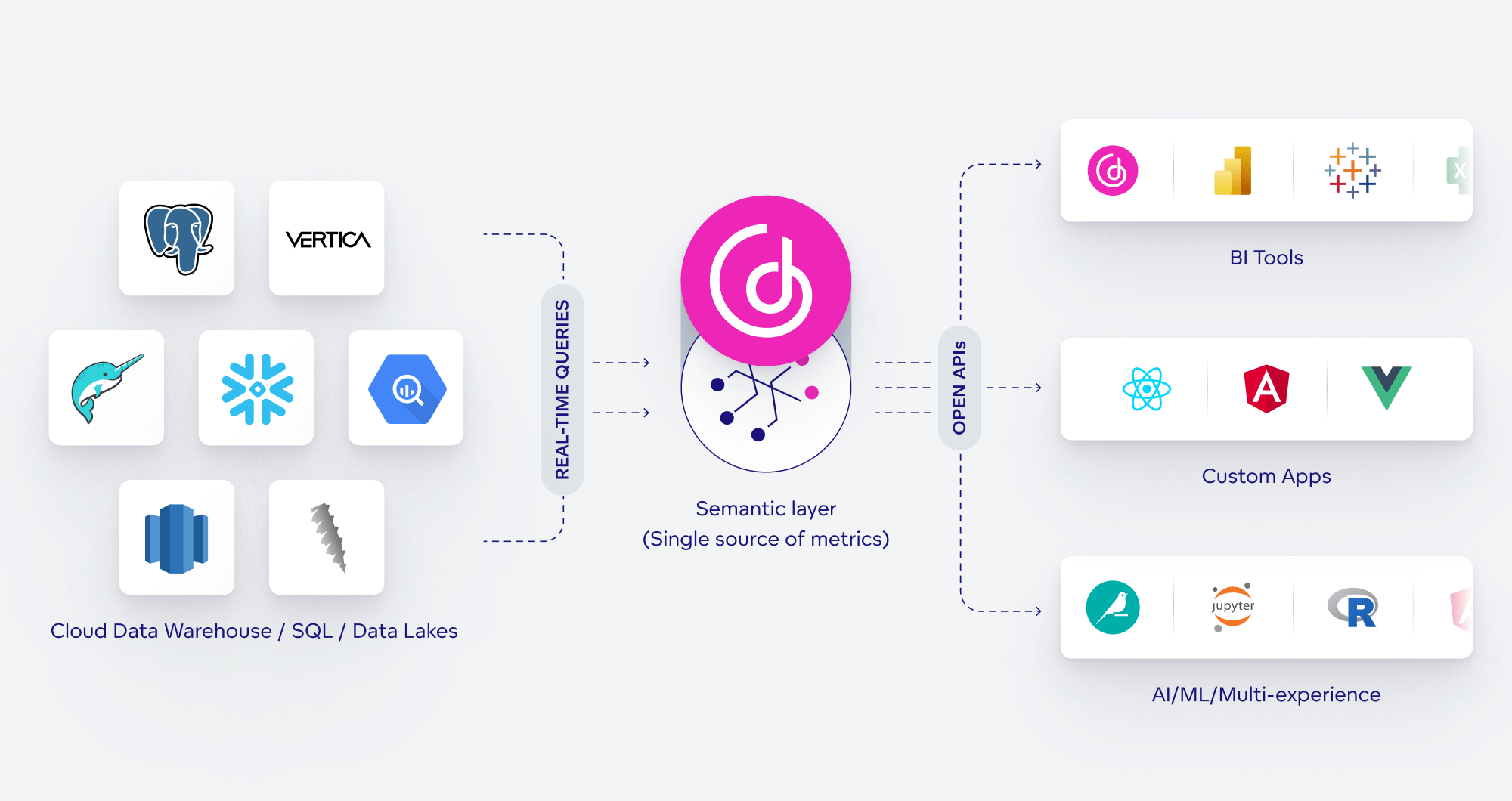Data Governance: All you need to know


Summary
Data is an essential part of every business, driving operations across all industries. This makes it one of the most valuable assets a company possesses. However, with great value comes great responsibility, and it is crucial to manage this wealth of data effectively and responsibly. Enter data governance.
This article explains why governance is a cornerstone of modern data strategies, what principles shape a successful framework, and how it supports organizations in balancing security, quality, and accessibility. It also highlights the practical steps for turning governance into action, from clarifying roles and responsibilities to implementing the right processes and tools. Readers will discover how governance builds trust in analytics, strengthens compliance, and ensures data continues to create value as businesses grow.
What is data governance?
Data governance is a framework of principles that manage data throughout its lifecycle, from collection and storage to processing and disposal. It outlines the necessary actions, processes, and supporting technologies to ensure effective data handling.
Data governance aims to maintain high data quality in a secure and easily accessible manner. Simply put, it governs who can access specific types of data and which datasets are governed under these protocols.

Data governance overview
Data governance and data management
Data governance encompasses policies and standards for managing data as a valuable asset, ensuring compliance and security. In contrast, data management involves the practical processes and technologies for collecting, storing, and using data, with a focus on accuracy and availability.
Why is data governance important?
Data governance is vital for organizations to ensure effective data management and utilization. Here are key reasons why data governance is crucial:
- Avoid inconsistent data silos across different departments by unifying data management practices.
- Establish standard data definitions to create a shared understanding of data across the organization.
- Improve data quality by identifying and rectifying errors in datasets, ensuring accuracy and reliability.
- Increase the accuracy of analytics to provide reliable information for informed decision-making.
- Develop and enforce policies to prevent data errors and misuse, ensuring data integrity.
- Help ensure compliance with data privacy laws and regulations, protecting the organization from legal risks.
Data governance framework
A data governance framework is a set of rules, processes, workflows, technologies, metrics, and responsibilities that guide how an organization collects, organizes, stores, and uses data. The data governance framework is part of the data governance strategy that defines and outlines the goals and direction for data governance across an organization, both internally and externally.
Data governance principles and components
As data is one of a company's most valuable assets, it is crucial to shape the data governance strategy based on well-defined principles. These principles ensure that the strategy effectively manages, protects, and leverages data to its maximum potential.
Various technologies and tools are available to apply data governance principles in practice. In data governance, three areas work together: people, processes, and technologies.

Data governance principles
Data accuracy
Data accuracy ensures that data is correct, precise, and free from errors. How can we achieve accurate data?
- Data profiling analyzes data structure, distribution, patterns, and anomalies. It scans tables to create profiles with statistics on missing values, data types, and distribution, helping users to quickly understand data quality, spot anomalies, and ensure accurate analytics for better decision-making.
- Data quality tools combine data accuracy, validity, completeness, and consistency. To achieve this, dbt can be used as a transformation tool, enabling data analysts and engineers to more effectively transform data in their warehouses.
Data consistency
Data consistency ensures that data remains uniform and consistent across different systems.
Start with data integration, which helps collect and merge data from multiple storage systems (e.g., data warehouses and data lakes) to create a unified view. You can use built-in ETL (Extract, Transform, Load) tools within analytics platforms or external tools like Meltano (for extracting/loading data) and dbt (for data transformation).
Once a unified dataset is established, effective master data management requires providing consistent terms and definitions of metrics to all tenants (departments, vendors, business units, and clients). The semantic layer maps physical data to a logical model, defining rules, relationships, and a common business vocabulary. A shared logical data model and metrics store maintain data consistency and integrity. With Headless BI, you can use consistent definitions across tools like Jupyter Notebook, Tableau, and Power BI through API integrations.

The position of the semantic layer
Data accessibility
Data accessibility ensures that data is readily available to authorized users. To apply this principle in practice, you can establish data catalogs and access control over your solution. To ensure data accessibility, it is beneficial to have all of the following:
- Semantic layer, which ensures data accessibility by using business-friendly terms for easy data interaction. It serves as a unified layer across the entire organization, including departments, teams, clients, customers, and vendors.
- Searchable repositories using Analytics Catalog, as a central hub for users to search, view, and organize analytical assets. The semantic layer enhances this functionality by allowing searches in familiar business terminology. It provides metadata for context, origin, and timestamps, and offers categorized views for easy discovery.
- A data catalog serves as a centralized repository that provides comprehensive information about the data stored within a platform, including metadata — information about data sources, structures (such as tables, columns, and data types), relationships between datasets, metrics, dashboards, visualizations, and other entities like users, user groups, and workspaces.

Metadata example
In a multi-tenant architecture, users share the same environment but can only access relevant data. This is achieved through access control, user grouping, assigning permissions, and restricting access with data filters.
Data compliance
Data compliance ensures adherence to legal and regulatory requirements by implementing policies and procedures for accurate, consistent, and responsible data management. It involves measures to protect personal data and ensure privacy under frameworks like GDPR, HIPAA, and CCPA. Regular monitoring and reporting on compliance is also required.
Data integrity
Data integrity requires that data remains accurate and consistent throughout its lifecycle. Data integrity involves various measures, such as data validation, backups, and security controls.
Data security includes controls for both the application and its users. Application security covers HTTPS/TLS encryption, separate credentials, and logical data models to prevent SQL injections. It ensures strong segregation in multi-tenant instances. User security involves centralized authentication and authorization, multi-factor authentication, session expiration management, and encryption to prevent unauthorized access and tampering.
Data stewardship
Data stewardship involves managing and overseeing data assets to ensure quality, integrity, and accessibility. It includes centralized data management, comprehensive data catalogs, granular access control, continuous quality monitoring, and compliance features. This ensures data is reliable, secure, and well-managed, supporting informed decision-making and operational efficiency.
Data transparency
Data transparency ensures that data governance processes and usage are clear and understandable to stakeholders, using data lineage and visualization tools.
Data lineage tracks data origin and transformations, providing a clear path from source to final output. This traceability helps users to understand data flows and all changes made through various systems and processes. Leveraging an analytics-as-code approach allows for version control, enabling users to track changes in data, models, and metrics over time, ensuring transparency and accountability. Integrating CI/CD pipelines allows teams to automate, test, and collaborate more effectively, enhancing the quality and reliability of analytics solutions.
To simplify data governance, use visualization tools like GoodData. GoodData offers an API-first, AI-powered, cloud-based analytics platform that empowers engineers with data definition, optimization, and visualization tools. The platform is user-friendly, open, and scalable, making it ideal for embedding analytics into SaaS products, internal BI, or large-scale data products.
Data governance roles
In a successful data governance plan, specific individuals take on vital roles with distinct responsibilities. Data stewards manage data quality and security for particular domains; data custodians handle the technical environment for data storage and processing; data users analyze and report data; data architects design the data architecture, ensuring alignment with governance policies; and compliance and legal teams ensure data practices comply with legal requirements. A data governance council, responsible for setting strategies and policies, oversees the entire governance effort.
Data governance solutions
Data governance is essential for analytics solutions across various industries, including healthcare, insurance, and financial services. Each analytics solution involves extracting data from multiple sources, transforming and loading it into data warehouses, and connecting it to analytics tools to generate shareable metrics and dashboards. Effective data governance ensures data quality, security, and compliance throughout this process, enabling reliable insights and informed decision-making.
Data governance best practices
Data governance strategies must be tailored to align with an organization’s processes, needs, and goals. Here are a few best practices worth following:
- Understand your data: Identify the data that is crucial for your business and where it originates.
- Organize your data: Structure your data to achieve a comprehensive view and enhance its usability.
- Manage data lifecycle: Implement policies for data acquisition, storage, transfer, and disposition at every stage of its lifecycle.
- Ensure privacy and security by default: For analytics, employ user authentication and authorization tools that comply with security regulations, and restrict user access through permissions and data filters.
- Continuous monitoring and adjustment: Regularly revisit and update your data governance strategy to ensure it continues to meet the needs of your customers and organization.
Data governance benefits
Implementing robust data governance provides several key benefits:
Data democratization
- Facilitates easy, secure data access for authorized users
- Empowers data-driven decisions, fostering innovation and agility
Standardized and trusted data
- Ensures data consistency, accuracy, and quality
- Builds trust, enables reliable analytics, reduces reporting errors, establishes a strong data culture
Compliance with regulatory requirements
- Maintains adherence to legal and industry regulations
- Reduces legal risks and enhances reputation by ensuring data privacy and security
Data governance trends
Current data governance trends include:
- Automation: Implement workflows for resolving issues, lineage tracking, and policy management to save time, reduce costs, and minimize human error.
- AI and ML integration: Use AI and ML to monitor data quality, detect anomalies, and suggest corrections, reducing manual effort and enhancing accuracy. Proactively predict and prevent governance issues.
- Data monitoring and lineage: Track data flow and transformations to ensure quality, detect errors, and reveal inconsistencies.
- Cloud-based governance: Ensure robust governance as companies migrate data to the cloud, enabling secure access from anywhere.
- Ethical data use: Implement frameworks to ensure ethical use of data, especially in AI and machine learning models.
Next steps with GoodData
Interested in enhancing your data governance with GoodData as your analytics and BI tool? Explore GoodData's comprehensive solutions, from data integration to advanced analytics and seamless sharing. Begin with a free trial to gain hands-on experience, or request a demo to ask questions and discover how GoodData can be tailored to your needs.
Experience GoodData in Action
Discover how our platform brings data, analytics, and AI together — through interactive product walkthroughs.
Explore product toursData governance FAQs
Companies generate and use more data than ever before, and governance ensures that this data remains accurate, secure, and compliant. It reduces risks while giving leaders the confidence to rely on data for strategic decisions.
Governance ensures that the data feeding analytics platforms is accurate, consistent, and secure. This reliability gives decision makers confidence in the insights they use to guide strategy.
Governance sets clear rules for data access, enabling business users to explore and create their own reports without compromising data integrity. It provides guardrails so self-service analytics remains both flexible and trustworthy.
Metadata documents where data comes from, how it is transformed, and what it represents. Strong governance uses metadata to create transparency, making analytics easier to interpret and reducing the risk of misinformed decisions.
Governance introduces standardized processes and reusable definitions for metrics and models. This consistency allows analytics platforms to grow across teams, departments, or regions without duplicating effort or creating conflicts.
Yes. When governance frameworks clarify definitions, enforce quality, and provide consistent access rules, business users can trust that analytics outputs are accurate. This increases adoption and reduces reliance on technical specialists for every request.


